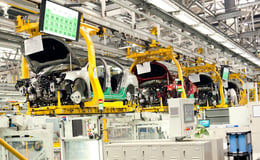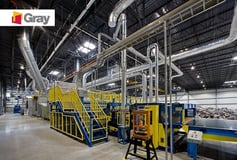Key components of an SCP Technology Implementation
Nicole Wanichko - March 09, 2021

The problem that every supply chain planner is trying to solve is how to make their supply chain as efficient as possible. To achieve ultimate efficiency, a supply chain must have end-to-end visibility, real-time monitoring, and accurate forecasting – but how do you juggle this? Supply Chain Planning (SCP) technology revolutionizes supply chain management (SCM), allowing planners to obtain the visibility and clarity necessary to run an orderly supply chain. While this is an excellent solution, a lot goes into implementing this technology and ensuring that it carries the features you need. Beyond this, all aspects of your supply chain and technology must work cohesively with one another to avoid bottlenecks and slowdowns. In a 2019 survey, 27% of industry professionals found synchronizing the supply chain and obtaining insight into supply and demand to be very challenging. With proper SCP technology, your organization will have more accurate demand forecasts and a more holistically integrated supply chain, solving some of the industry's most prominent challenges.
Supply Chain Planning
Before getting into technology implementation, we’ll run through a refresher on the steps of supply chain planning and how to implement it. The first step in effectively planning out your supply chain is through demand planning, which consists of forecasting based on historical data and planning software. This data will then identify patterns alluding to future demands, which the supply chain planner can then translate into production planning and logistics. Following production, we move into sales and operations planning (S&OP) and materials requirements planning (MRP). From an outsider's perspective, this process may seem simple, but it is quite the opposite.

If supply chain planning is accurate, it optimizes manufacturing and product delivery; increasing sales, lowering costs, and managing relationships with suppliers. A supply chain's efficiency is paramount to an organization's success, translating to customer satisfaction and company growth. While this is the goal, it brings us back to our original problem – how do you achieve this efficiency?
SCP Technologies
In-Memory Technology
As we move into the age of Industry 4.0, implementing accurate and efficient technology is now a necessity for supply chains. One of the most excellent technological tools you can introduce to your supply chain is in-memory technology, something flexis has been using for many years. An in-memory technology operates real-time and more efficiently than disk-drive memory. Rather than performing data processing on external hard drives, an in-memory operates within the memory of the cloud. This eliminates time-consuming data transfers, allowing you to communicate with supply chain team members instantly, ensuring that your supply chain runs smoothly. To give you a clearer understanding of in-memory databases, we'll discuss their primary benefits.
First and foremost, in-memory databases are elite in processing data. With incredible speed and power, planners will have access to real-time data across their entire supply chain, so they can replicate and distribute information as needed. It also holds the capability to make complex calculations about forecasting and possible disruptions to prepare you for anything. Additionally, in-memory allows you to review several inputs and channels simultaneously to offer you complete, end-to-end visibility. With this data, you will receive accurate and comprehensive reports, enabling you to handle large volumes of data with little lag time from manually translating complex spreadsheets.
Finally, one of the most beneficial and unique aspects of in-memory databases is their ability to run detailed simulations, enabling things such as scenario validations in real time. As a result, customers are able to make planning and SCM decisions quickly, efficiently, and flexibly. This will allow you to identify bottlenecks before they occur, agile enough to make real-time changes in operation, in addition to avoiding disruptions so that you can increase productivity and eliminate wasted costs.
With these advanced analytics, you can track data within your supply chain, and once obtained, the in-memory software will remember your data. This feature will allow you to easily access historical data and continue to increase accuracy in future forecasts. Furthermore, it is a key driver in enabling the Digital Supply Chain Twin as it connects planning to execution - paramount to a successful supply chain plan.
Multi-Dimensional Monitoring
The next innovative supply chain logistics technology you may want to implement is multi-dimensional monitoring software. This is a real-time and self-adaptive software that allows you to monitor every step of your supply chain simultaneously. With increasing digitization and the implementation of Industry 4.0, there has been a sharp increase in data volumes, greater complexity, and, as a result, a large number of planning elements and dimensions. Hence, there's a technological need for something that enables the user to combine all planning-relevant structures (product, part, plant, market, time horizon) and the corresponding levels and dimensions in a multidimensional model. All necessary planning information is available and linked throughout the system. Thus, processes from S&OP, supply chain, and production environments can be mapped and linked with each other.
Not only will this monitor your products and materials during the production process, but will also allow you to prepare better when managing your inventory because you will know precisely how many products you have in process and where they are in your chain. The software will notify you of any disruptions, identifying which requirements have been fulfilled and if any will not be met.
With a holistic view of production, warehouses, and timing, you will achieve end-to-end real-time visibility. As a result, you can make decisions intelligently and quickly, allowing you to act proactively rather than reactively. The benefits don't stop there. With such clarity and visibility, you will minimize logistics costs due to reduced bottlenecks and more precise decision-making.
Machine Learning
It may seem as though we’ve already discussed machine learning above. After all, don’t these highly capable analytics technologies qualify? Well, yes – but there’s more. Machine learning encompasses more than just high-tech software; it is a subset of Artificial Intelligence (AI) that allows supply chain systems to learn and adjust without being specifically programmed to do so. This technology uses data to train a computer model to recognize patterns and react accordingly. This means that with all of the latest and complex technology you're implementing, you can take it one step further and use machine learning to identify and manage the relationships of these systems for you. One of the most important features of a supply chain is cohesiveness. With machine learning, you can achieve cohesiveness like never before while utilizing other technologies to create a more efficient and resilient supply chain.
 Diving deeper into machine learning, these monitoring tools are further innovating supply chains by focusing on user experience (UX). While machine learning will advance the automation of your operations, incorporating additional UX technology delivers data to you in an even more comprehensive manner. This furthers the conversion from data to a supply chain plan, ensuring a user-friendly experience, and further maximizing your supply chain's efficiency and visibility.
Diving deeper into machine learning, these monitoring tools are further innovating supply chains by focusing on user experience (UX). While machine learning will advance the automation of your operations, incorporating additional UX technology delivers data to you in an even more comprehensive manner. This furthers the conversion from data to a supply chain plan, ensuring a user-friendly experience, and further maximizing your supply chain's efficiency and visibility.
Implementation
In implementing any new technology into your supply chain, there are some preliminary steps you should take. To begin, plan what you want to achieve in upgrading your SCP process. Define specific areas that can be improved with the implementation of technology. Once this is determined, you can begin shopping around for technology that best suits your needs. It can be extremely beneficial to obtain the services of an expert supply chain manager who will lay out the best solutions for your organization's needs and help you implement them. One of the biggest mistakes you can make in implementing a lot of new technology at once is failing to connect them properly. With the help of an expert service provider, you can ensure that your systems work together seamlessly and are the right fit for your needs. A provider will guide you in maneuvering systems such as machine learning in coherence with other technologies so that you can use them efficiently. With cohesive and optimized technology, your supply chain will achieve maximum efficiency. You will have complete visibility of your supply chain operations while accessing accurate and real-time data to make certain that the decisions you make are the right ones.
LATEST POSTS
- Understand Circular Economy in The Manufacturing Industry
- How Can Industry 4.0 IT Integration Be Achieved Smoothly?
- The Significance of Order Sequencing in Discrete Manufacturing
- How to improve your Supply Chain Management: The Power of Control Towers
- Optimizing Human Resource Scheduling in Manufacturing: A Technological Approach



